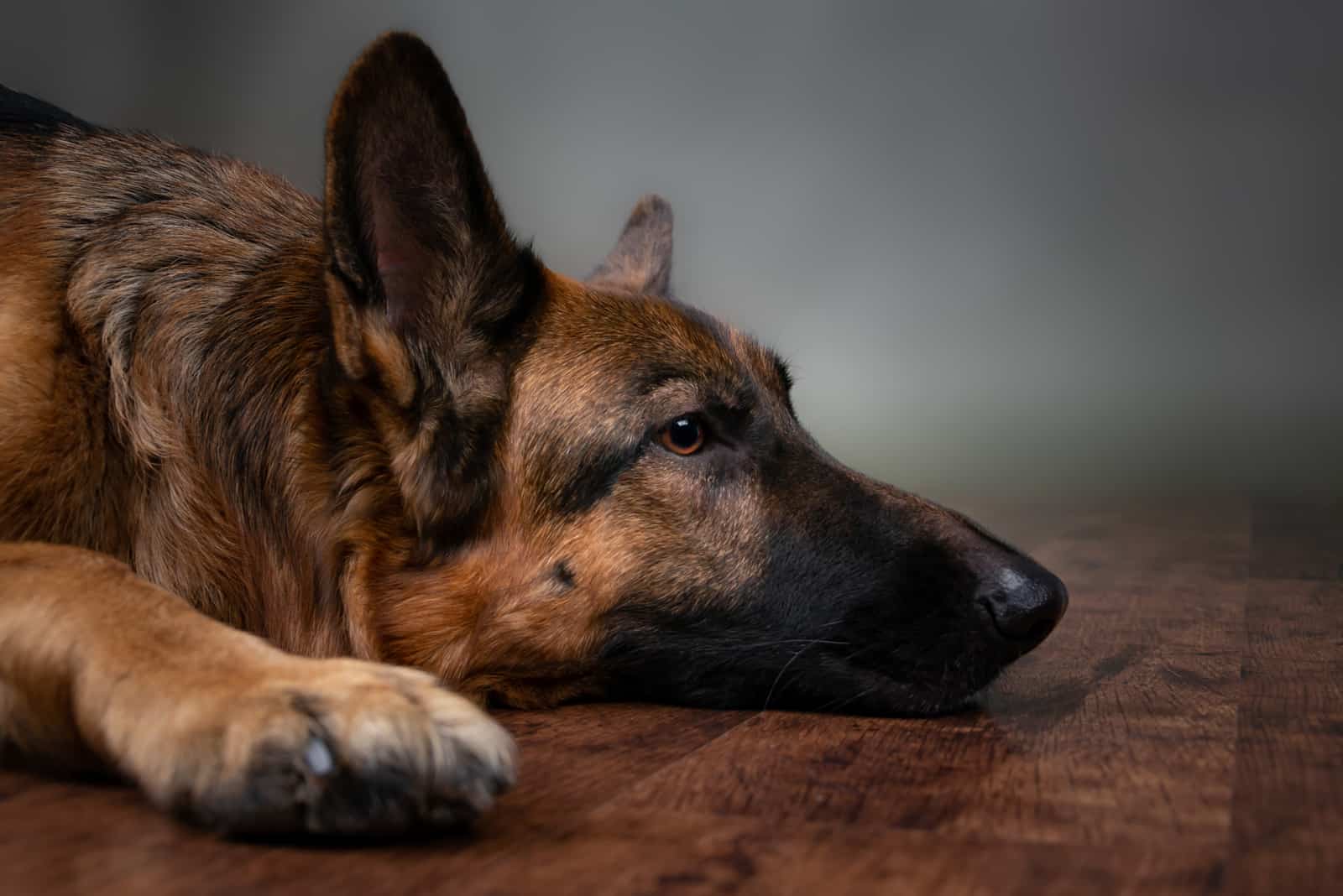“I know it’s gross, but my dog’s earwax is a different color — what do I do?”
We know that earwax isn’t exactly an interesting topic for discussion, but it is essential that you know everything that you can about what goes on inside of your dog’s ears in order to make sure they are okay.
A dog’s ear consists of an inner ear, a middle ear, and an outer ear canal, all of which are important when it comes to regulating the ear as a whole so that your dog can hear properly.
Earwax is also of key importance when it comes to keeping your dog’s ear healthy because it serves to remove unwanted dust and other chemicals from the ear in order to prevent damage.
Earwax is also known as cerumen. It forms naturally in the external parts of the ear canal, emitted by certain glands located within the ears of your dog.
Its oily texture will shield parts of the ear from dead cells, debris, bacteria, dust, and a variety of other chemicals that are not good for your dog.
Because it is oily in texture, it guards water and other liquids from coming into the eardrum.
If your dog’s earwax color changes or if your dog develops excessive earwax, it can become worrisome. Dog owners might be wondering if their dog’s health is in any way jeopardized because of ear problems.
We have prepared for you a dog earwax color chart so that you can monitor your dog’s earwax. Keeping track of your dog’s earwax will help you determine whether or not it is time to pay a visit to the vet.
Besides the common causes of infection, we will also explain how you can cleanse your dog’s ears from any unwanted gunk.
Dog Earwax Color Chart: An Overview
You will be surprised to find that your dog’s earwax can come in many different colors.
The chart below will show if your dog has a healthy ear or if it might be undergoing certain changes, such as ear infections.
[table id=369 /]
Dog Earwax Color Chart Summary
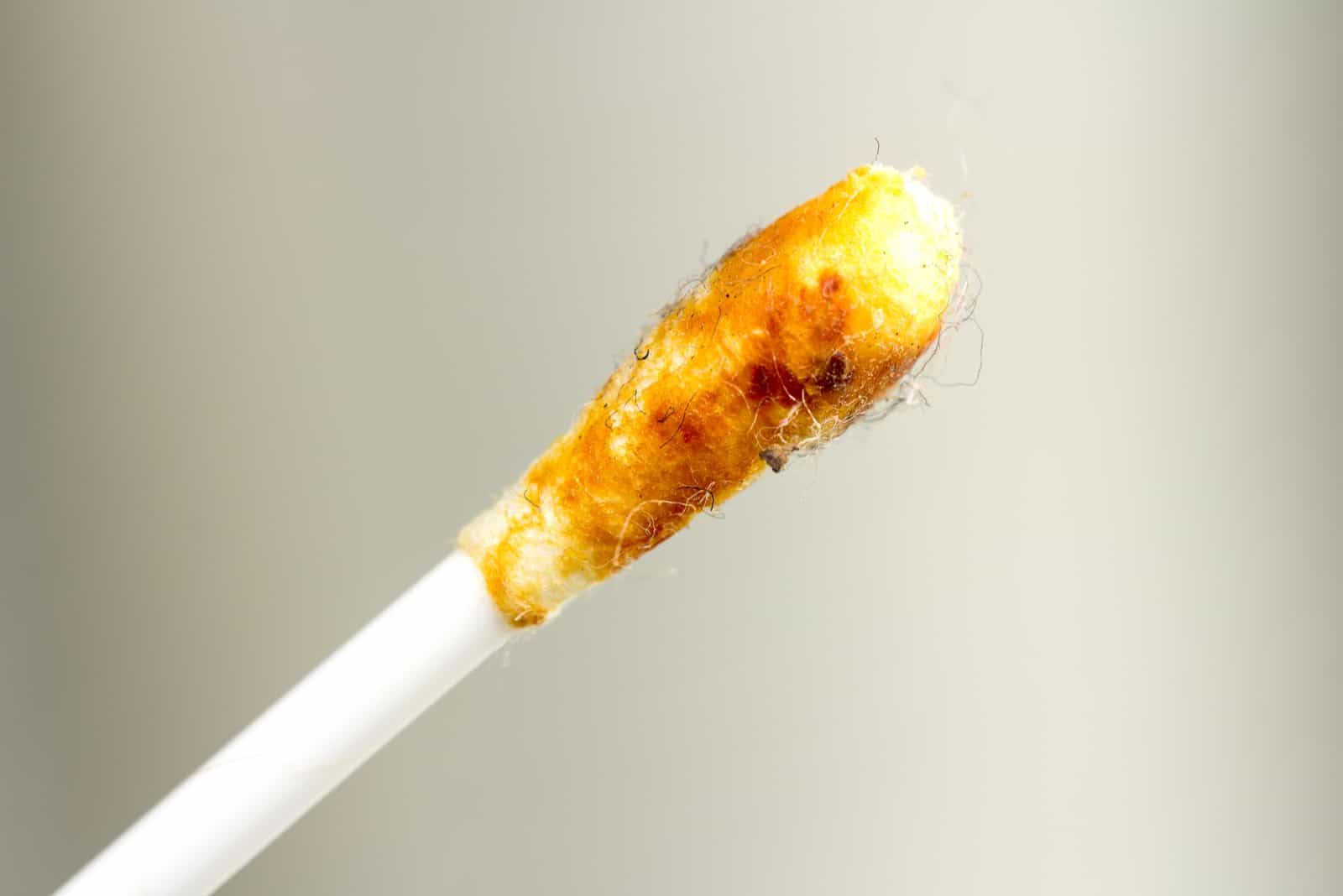
As we have described above, if your dog doesn’t have any discharge, it probably is healthy and there is nothing to worry about. However, if your dog has any kind of itchiness or inflammation of the outer ear, it might be a sign of allergies.
What Color Should Dog Earwax Be
If your dog has dark brown or black earwax, it might be a sign of yeast or bacterial ear infections, which means that you should take your dog to the vet for a checkup.
It is quite normal for dogs to have light brown earwax, but if it smells bad or your dog’s ear is inflamed, it could indicate the presence of an ear infection. In this case, you should consult your vet.
Normal dog earwax is usually yellow, but if you notice that there is any kind of redness or swelling developing, it might be a sign that an infection is progressing.
Red earwax is usually a sign that there is a wound inside the ear caused by injury or bites and tears. You should talk to your vet to make sure you know the reason behind the bleeding.
Green earwax is related to yeast infections as well as fungal infections if a bad smell accompanies it. Consult your vet about how to treat your dog’s infection.
Gray earwax may or may not indicate the presence of an ear infection depending if it is related to a build-up of dirt from the environment. If you clean your dog’s ears and it turns back to a normal color like light brown or yellow, you’re good to go!
Another thing to keep in mind when looking at earwax is the earwax texture and amount.
If your dog’s earwax is gooey instead of soft, it could be a sign that you should visit the vet.
Likewise, if there is a huge build-up as a result of earwax overproduction, there might be something else going on that you want to keep an eye on.
Read Also: Black Gunk In Dog Ear: What Causes It And How To Solve It
How To Clean Your Dog’s Ears
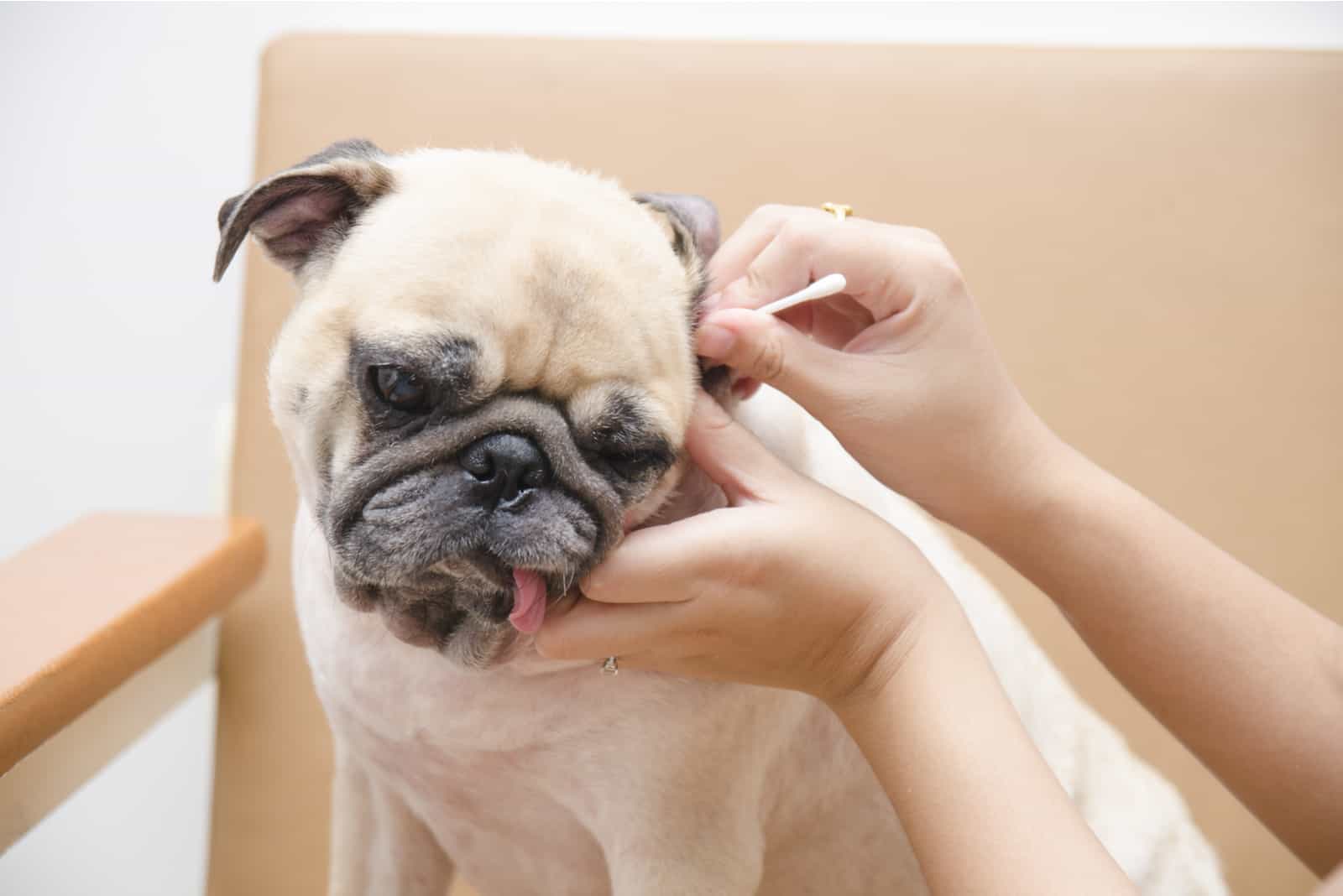
Hopefully, the dog earwax color chart above was helpful, but now you might be wondering how to clean your dog’s ears.
No worries – we’ve got you covered!
We know that cleaning your dog’s ears can be a hassle, even though it is necessary for healthy ears, so we have provided detailed steps on how to do it so it is as stress-free as possible.
Step One
The great thing about cleaning your dog’s ears is that you don’t need to spend a crazy amount of money to get all the materials you need.
Just take a cotton ball and an ear cleaning solution that your vet can recommend.
You want to avoid using other cleaning fluids as they may have irritating particles such as fragrances that will do more harm than good to your pooch’s ears.
Do not use cotton swabs (also known as q-tips) as they are known to injure sensitive ear parts, such as the eardrum or ear canals. They can also push earwax in your dog’s ear, making it clog due to earwax buildup.
Step Two
Coax your dog into a comfortable position and pour the ear cleaner solution into its canals for approximately 30 seconds.
Then, gently rub the base of the ear so that your dog doesn’t experience discomfort. Do this for approximately 40 seconds.
You want to make sure that the applicator’s tip doesn’t come in contact with your dog’s ears in order to prevent contamination, especially if you have other dogs that are using the same solution.
If by any chance the applicator does happen to touch your dog’s ears, disinfect it with alcohol before placing it back into the container.
Step Three
Your dog will proceed to shake his or her head after this somewhat uncomfortable procedure.
This is great because while it gets rid of the solution from the ears, it also helps detach the earwax so that it is easier to remove in the next step.
Step Four
Now, you will take the cotton balls and use them to clean the muck that comes out of your dog’s ears.
Step Five
You will want to repeat all of these steps several times until there is no more gunk exiting your dog’s ears. When you wipe your dog’s ears with cotton balls, there should not be any more ear discharge.
You want to make sure that you are meticulous in your dog’s ear-cleaning procedure.
Make sure to praise your dog for his or her good behavior!
Dogs and Earwax Cleaning
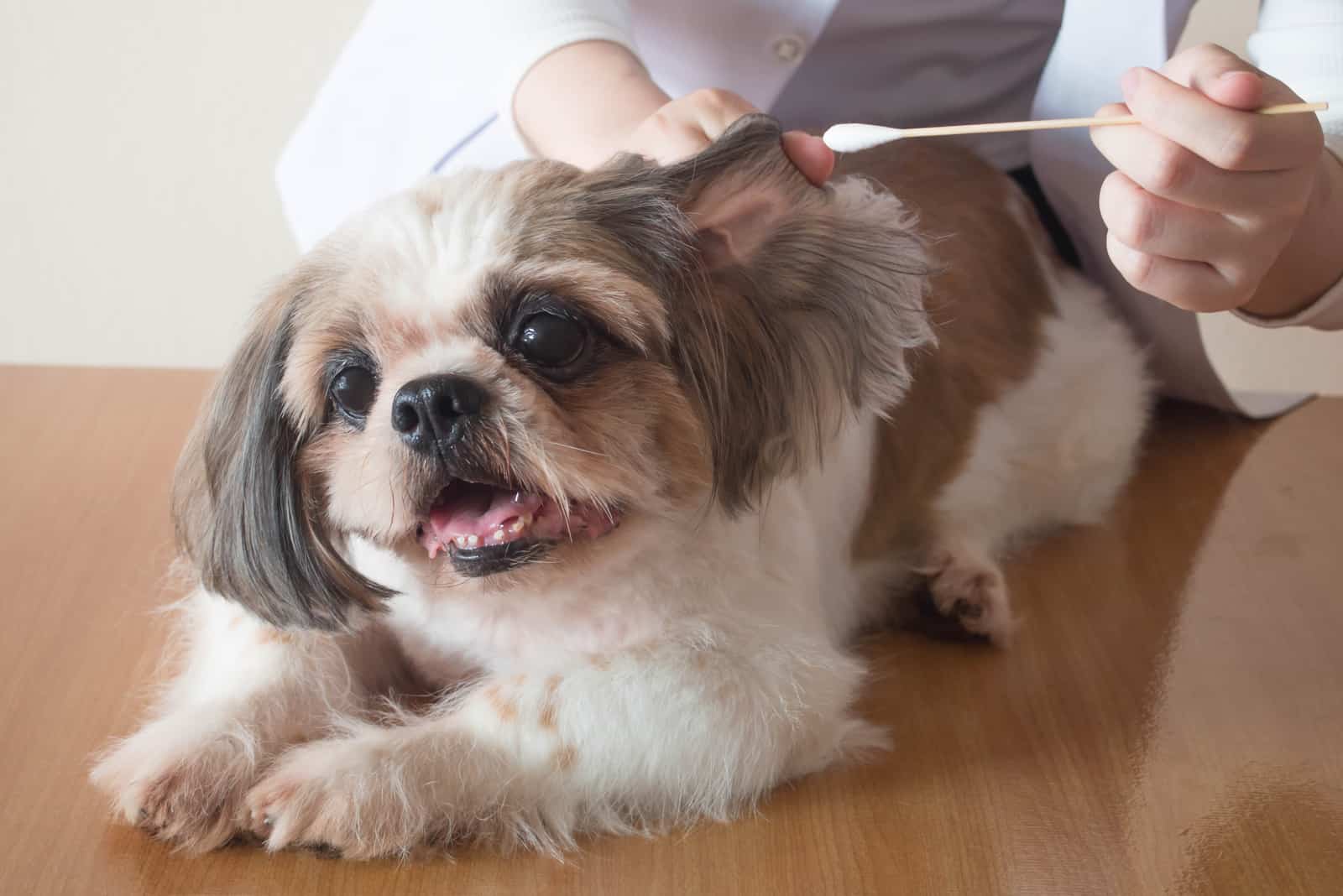
Not all dogs are the same. Some of them need to have their ears washed more often due to overproduction of earwax, or ear infections, and some are more impatient with ear-washing procedures.
Consult a vet about how often you should clean your dog’s ears. Once you have a proper schedule associated with earwax cleaning, you will become more observant of your dog’s “normal” when it comes to earwax.
You also might want to begin washing your dog’s ears when he or she is at an early age so that the prospect of doing it is normalized.
A healthy ear in a dog is always pink and odorless. You want to make sure that you don’t overdo it when it comes to ear cleansing because the irritation associated with too much cleaning can lead to an infection.
Note About Earwax Cleaning
If your dog behaves in a different way than it usually does when you clean its ears — such as wincing in pain — you might want to consult your vet.
Some dogs can be very anxious about ear cleaning methods, so you can do certain things to make the prospect less terrifying for them.
For instance, you can play with them or tire them out through walks right before the procedure. You might also give them treats, which will keep them occupied during the procedure.
Some dogs are more comfortable with knowing what materials are being used on them during the process, so you might want to desensitize them by showing them that the materials you are using are harmless.
You also may not want to quicken the process, but slow down if your dog shows symptoms of anxiety.
Even while you are not cleaning your dog’s ears, you might want to have it get used to having its ears touched so that it knows not to be scared when you finally end up cleaning its ears.
If all of this doesn’t work, you can always have a professional do the job.
Are Certain Dog Breeds Prone To Build-Up?
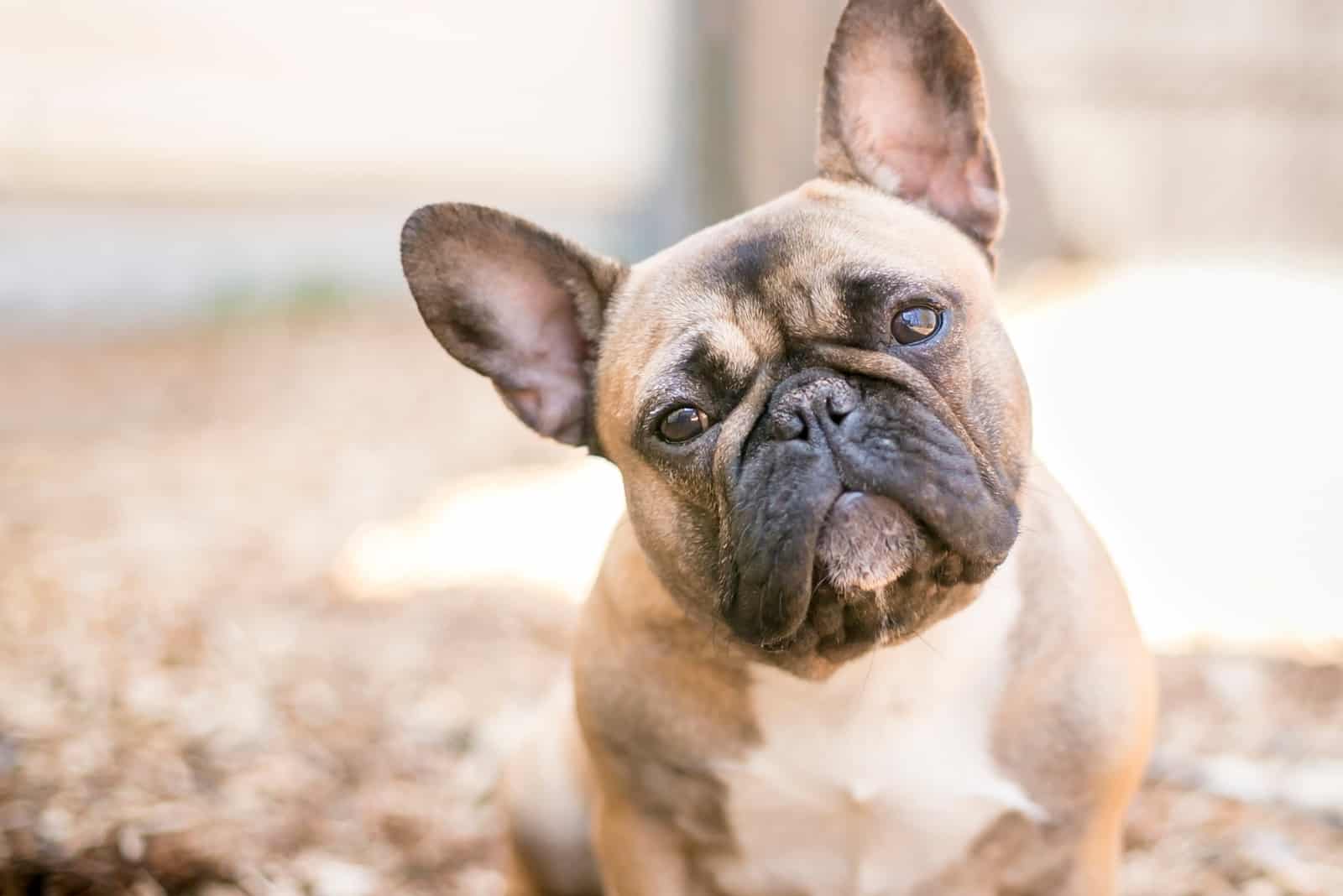
Yes. There are certainly some dog breeds that are known for having a greater production of earwax than others such as bulldogs, poodles, cocker spaniels, and basset hounds.
You might want to check if your dog is a breed that might have earwax issues.
These breeds have more earwax problems because of how their ears are shaped and whether or not hair grows from their ear canal. There was even a debate on whether cropped ears in dogs caused more ear infections.
They also just might be genetically predisposed to more earwax production.
But, sometimes it isn’t all in the genes.
A Dog’s Environment And Earwax
The environment can play a huge role in how much earwax your dog ends up developing.
You might notice that if your dog spends a lot of time swimming, he or she will develop more earwax.
It is well known that liquids are the culprit to many ear infections because they are the perfect environment for bacteria to thrive, so you always need to be wary of taking care of your dog.
You might want to put cotton balls in your dog’s ears when he or she goes to the beach or pool for a swim because that will protect the water from coming into his or her ear canals.
You also might want to be careful that hair doesn’t fall into your dog’s ear canals when he or she is receiving a haircut because hair build-up can also be another reason for infection.
Some dogs love to play in dirt. If you live in an environment where dirt and dust readily fly in the air, you might want to direct your dog to ear-friendlier physical activities.
When Should I See A Vet?
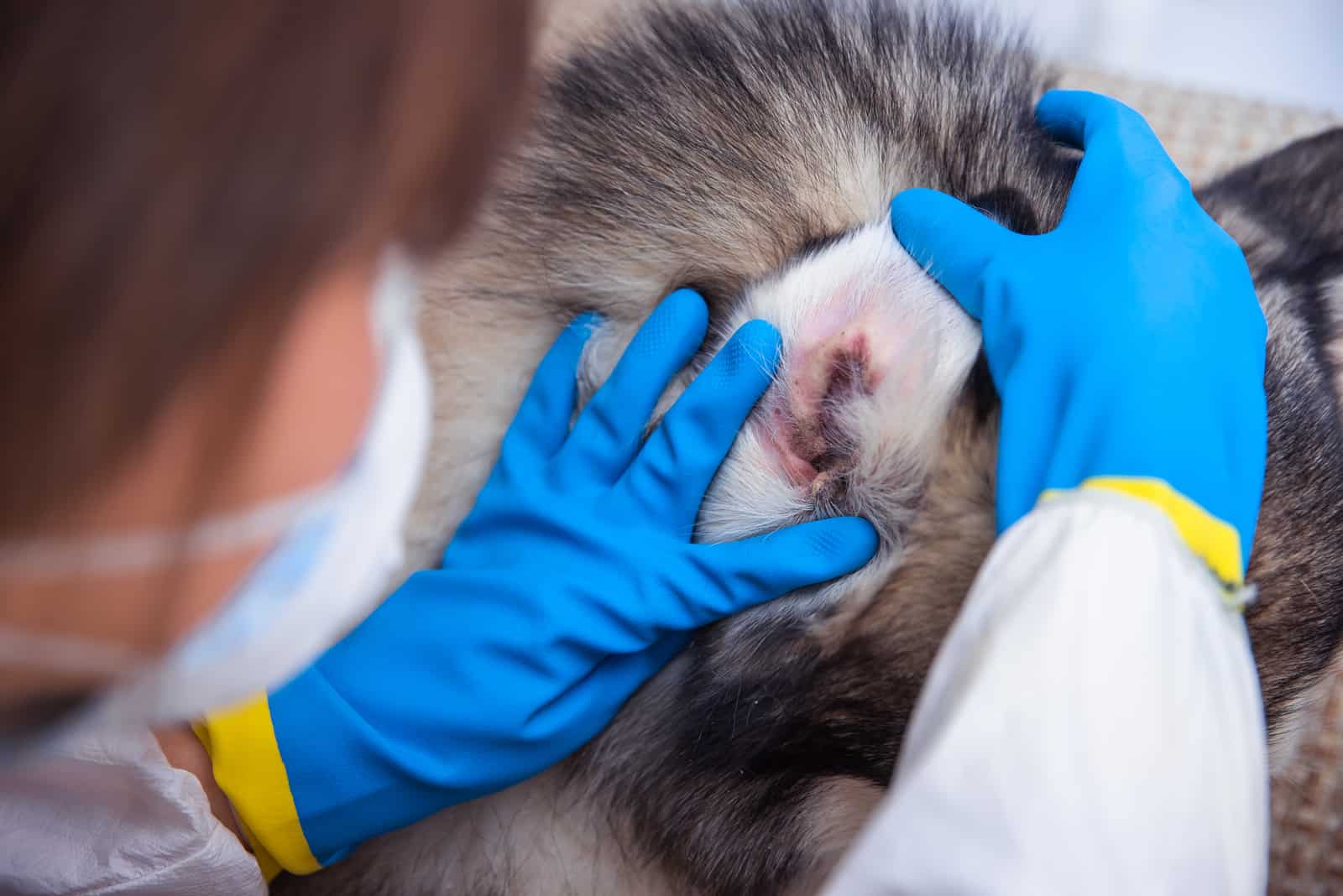
As you have already learned, the best way to tell if your dog’s ear is healthy is by looking out for what the colors shown in the dog earwax color chart mean for your dog.
You don’t have to worry if your dog’s ears are cold or if it scratches its ears every now and then, but if your dog starts scratching, shaking his head very often, or has red ears, it might be a sign that your dog has an infection.
If your dog shows these signs, among others we have discussed, you might want to consult a vet when it comes to how to treat your dog’s possible ear infection.
Sometimes, you might not notice that an ear infection is present because the outer ear is not red, so a vet will help determine whether or not your dog has an infection through a proper checkup.
Your vet will use an otoscope to check for any sign of infection, and will help you determine what to do next.
Ear Infection Causes
Ear infections can be a result of a variety of causes. They can even cause restlessness in dogs during the night.
Dog allergies are one of the common causes of ear infections. Because of food or environmental reactions, your dog can experience an overproduction of earwax that might lead to ear infections.
Another reason for ear infections can be pesky little ear mites. These are tiny parasites that strive in earwax and the environment of the ear canals.
You usually can’t see ear mites, which is why visiting a vet is necessary because he or she has the proper tools to examine your dog properly.
Although allergies are usually the number one cause of ear infections, others are a result of a variety of conditions that your vet can help you determine, some of which include:
• Non-neoplastic polyps
• Autoimmune diseases
• Keratinization disorders
• Endocrine diseases, such as hypothyroidism or hormonal imbalances
• Tumors, which can be either benign or malignant
• Foreign bodies that we have discussed such as plants, debris, hair, etc.
• Hypersensitivity, such as food allergies or allergies of other kinds
After your vet has figured out the cause for your dog’s infection, he or she can develop a treatment plan for your dog.
More On Dog Ear Infections
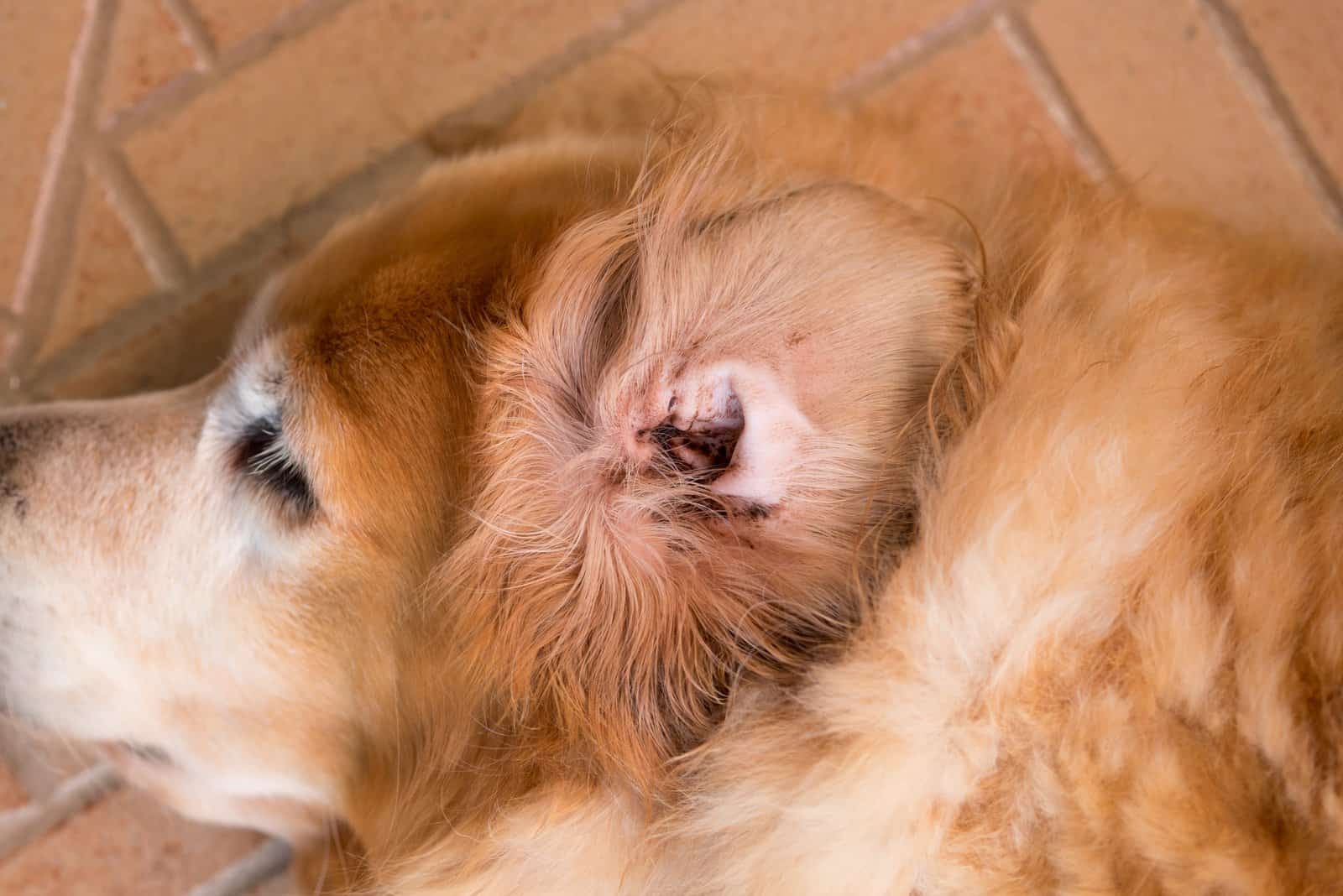
In case you want more information about the signs of an ear infection as well as what causes them, we have got you covered.
Otitis externa is the term that is commonly used for an outer ear canal infection.
We have already learned that such infection and inflammation is commonly caused by allergies, bacteria, ear mites, and yeast.
A dog that has an outer ear infection will exhibit symptoms of:
• Whining
• Head shaking
• Too much earwax discharge
• A foul smell associated with the earwax discharge
• Scratching of the ears due to itchiness
• Red skin due to inflammation
• Ear flap with scabs or crusts
In case your dog hasn’t been treated properly, more extreme symptoms of ear infection might be:
• Hearing loss
• Strange eye movements
• Loss of balance due to middle ear infection
Types of Infections
Malassezia pachydermatis
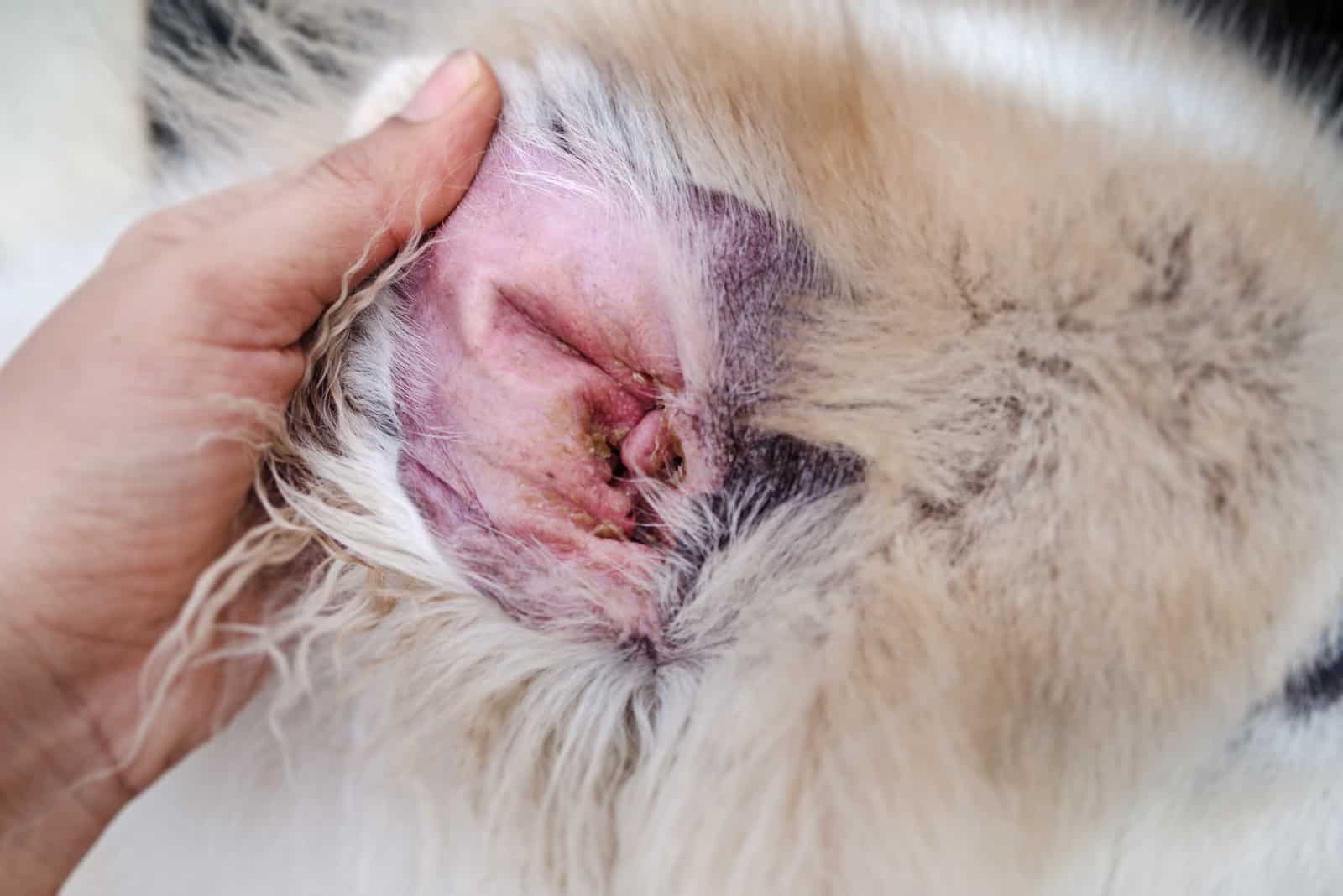
You might be wondering what sorts of infections are out there that can harm your pooch.
Malassezia pachydermatis is the most prevalent type of yeast infection of the ear infections when it comes to dogs.
This microorganism is commonly found in the ear of your dog, but an overproduction can occur under the right (or perhaps wrong) conditions, which is why you want to make sure that your dog’s ear isn’t exposed to excessive moisture.
You can usually tell that Malassezia pachydermatis is this culprit due to a strange smell in your dog’s earwax accompanied by grayish to brownish discharge.
You might also observe that there are crusts on your dog’s ear flaps, and that matting hair is common when this microorganism takes charge.
When your dog develops this yeast infection, you might observe that the ear canal becomes smaller and the skin in your dog’s ear becomes brownish or gray.
Other causes of infection
Another prevalent yeast infection is called Candida albicans, but a Malassezia pachydermatis yeast infection is much more common.
Infections caused by bacteria can sometimes accompany yeast infections or can fester alone.
You might have heard that the two most prevalent bacteria that festers in dog’s ears are Staphylococcus pseudintermedius and Pseudomonas spp.
If your dog’s ear canal smells particularly gross, the culprit might be a bacterial infection instead of a yeast infection, which doesn’t tend to smell as bad.
That is usually the only telling sign that you can make out when it comes to determining whether your dog’s infection is a result of yeast or bacteria if you exclude a culture test, which requires a visit to your vet.
Figuring out what microorganism is causing the infection is extremely useful for vets when they want to determine how to treat your dog, which is why it is always best to go for a visit if you are unsure of what to do.
When a vet does a sample test, he or she can narrow down the medications that will help treat your dog instead of giving it incorrect medicinal care.
It is important to note that usually, the different types of yeast and bacterial infections we have mentioned are not primary causes of ear infections, and only develop when the conditions in the ear are well-suited for culture to thrive.
Ear mites are the most typically known organism that act as the sole cause of an ear infection, along with Microsporum canus and Trichophyton mentagrophytes.
Other problems such as demodectic mange, tick infestations, and sarcoptic mange might also play a role in causing ear infections.
Learn More: Dog Ear Positions Chart: 5 Ear Positions You Need To Know About
Conclusion

Photo from: @nina97_
We hope that you make good use of the dog earwax color chart, and that we have answered all of your questions about ear infections, causes, cleansing, and much more!
Dogs certainly produce a varying amount of earwax, but we hope that you have realized that all you have to do is make sure to look out for your dog when it comes to any change.
Just by following the color chart, you can inform yourself about what is going on in your dog’s ears.
You have also learned that it is great practice to check the amount of discharge that your dog’s ears release because an overproduction can be a sign of an underlying health issue.
Also, make sure to look at texture!
The most important key to having a healthy dog is to make sure you treat him or her as soon as you notice the signs of illness.
If you maintain a good ear cleansing schedule and know your dog earwax color chart inside out, you will be able to prevent most infections from arising.
Make sure to keep your dog on a healthy diet because what your dog eats can definitely affect your dog’s health overall.
This way, you will decrease the likelihood of your dog developing not only an ear infection, but all sorts of illnesses that will keep him from being the healthiest version of himself!
Read Next: Dog Urine Color Chart
